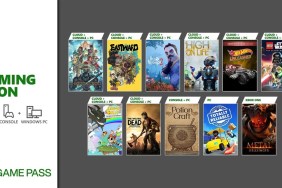How to miss a slam dunk.
NBA Street Homecourt is called NBA Street Homecourt because we already have a video game franchise called “Monkey Ball.”
NBA Street Monkey Ball, however, would better describe the most apparent difference between this game and the games of NBA Street past. Whereas super over-the-top dunks have always been Street staples, the dunks in Homecourt up the ante by adding simian-like acrobatics and aggressive hoop-rape that could only be motion-captured in a spider monkey cage.
[image1]For those new to NBA Street, the EA Big version of basketball opts for three-on-three basketball with the emphasis on ridiculous dribbling tricks and absurd dunks. The quick paced arcade feel of the original NBA Streets is preserved in Homecourt, and at first the only observable difference between this and its ancestors is the enhanced resolution of the next generation graphics.
Back again is the “game breaker” feature which allows teams to unleash high scoring super moves by building up the game breaker meter. Jukes and trick moves, as well as dunks and steals, increase points towards the gamebreaker. Once used, the game breaking team must again perform tricks to increase the number of points their gamebreaker is worth.
However, in Homecourt, the gamebreaker controls have replaced the right-stick contortions of last year’s installment with . . . nothing. Instead of messing around with the right stick while in the air, in Homecourt, you simply charge up your gamebreaker with more dribbling tricks. While the right-stick wasn’t always intuitive, the removal of it without any new mechanic seems a step backwards.
Not that walking ever happens in the game. Dribbling might be closer. Insane breakdance dribbling is probably the best description. By spamming on the two trick dribble buttons and “modifying” them by holding down either or both of the bumpers, your player will spin and flip around like a gerbil on PCP.
[image2]But that’s nothing compared to the new “double-dunk” feature. You charge up a dunk by holding down the dunk button while in the air, and if you release it at the last possible moment, your player will perform a spectacular “double-dunk.” In these, your player catches the ball after the dunk, usually with his feet, and then dunks the ball again while in the air. During double dunks, the players climb all over the backboard and the hoop with chimpanzee-like agility, thrusting the ball through the hoop repeatedly. Of course, for these rule- and rim-bending feats, you are awarded two points.
The new offensive gameplay features, like the double-dunk and a new “jump-off” mechanic which propels your player into the air by using a crouching teammate as a ladder, are more exciting but less game changing than the subtle defensive “shove” move. Big players now have an advantage over small dribblers, and can throw them on the ground with a single shove. Maybe this feature was in the earlier versions, but it didn’t play as much of a role as it does now.
However, for the new slick graphics and the few new additions, this NBA Street is too much like the previous ones in its initial promise and then quick disappointment. The gameplay is quick and easy, but it is also repetitive and frequently boring. Once my baller, Phurry Crocket, was labeled a “steals” master, the opposing teams would rarely be able to get the ball past half court. Phurry would steal and then jack up threes until the game was over, declining even to bother with the time-consuming gamebreakers.
It doesn’t help that the game’s main mode, the Homecourt Challenge, is uninspired. The idea is that Phurry Crocket has to travel to actual NBA stars’s homecourts, win a series of games with different rules, and finally get to defeat the game’s poster boy—Carmelo Anthony—at the fictitious and opportunistic “Jordan Brand Court.” The challenges start repeating themselves after just fifteen minutes of play, and the rewards—some new shoes and outfits—are pretty lame.
[image3]The game’s serious and nostalgic A&E Biography-style presentation jars with the absurd on-court antics. These clips are narrated by over-serious voice-over, and visually just show still pictures of the austere, player-free, courts. Their slowness and seriousness seems the exact opposite of the gameplay they frame: which is fast and whimsical.
Other game “modes” are just versions of the basic pick-up game with different rules. Play a game with no gamebreakers! Play a game with only gamebreakers! These aren’t modes, just basic options, and seem disingenuous when marketed as such.
The NBA franchise is marketed well, and most of the league’s best players are well-represented by their onscreen avatars. Unfortunately, you can’t change their attire, and it’s common to have each of your three players wearing three different colors of jersey.
You also can’t do much with your created character. Your baller’s facial appearance is the amalgamation of two actual NBA stars faces. Phurry Crocket was the child of Yao Ming and Steve Nash, and he didn’t look half as bad as that sounds. Beyond that, though, customization options are lacking. Even earlier NBA Streets allowed you to customize your palette of dunks; here you just choose a real NBA player to “play like,” and you’ve got all of that player’s attributes.
[image4]Finally, the online game doesn’t survive the test of interest. Control is often laggy, and the game often devolves into the double dunk-a-thon that one would expect. You can’t bring your own player into the game, and ranked matches often feature the same familiar all-star players.
Worst of all, though, is actual physical pain induced by an extraneous button. The turbo button is mapped to the right trigger. Since there is an unlimited supply of turbo, it’s frequently easy to go whole matches with the right trigger depressed. However, by way of anatomical physics too difficult to go into, the combination of holding down the right trigger and furiously mashing the facepad buttons with your right thumb causes some troubling carpal tunnel effects. Right now I’m dictating this review to the trained monkey we keep in the office.
But that monkey is only trained to like good original games, so even though he sees a future for more monkey-like sports simulations, he is going to pan NBA Street Homecourt. The gameplay becomes repetitive quickly and the campaign is over without much fuss. In the end, this fast-paced game falls victim to its own velocity.
-
Looks good
-
Double-Dunks
-
Same over-the-top formula
-
With nothing else added
-
Thin customization options
-
Even skinnier modes
-
Quick, repetitive, campaign










